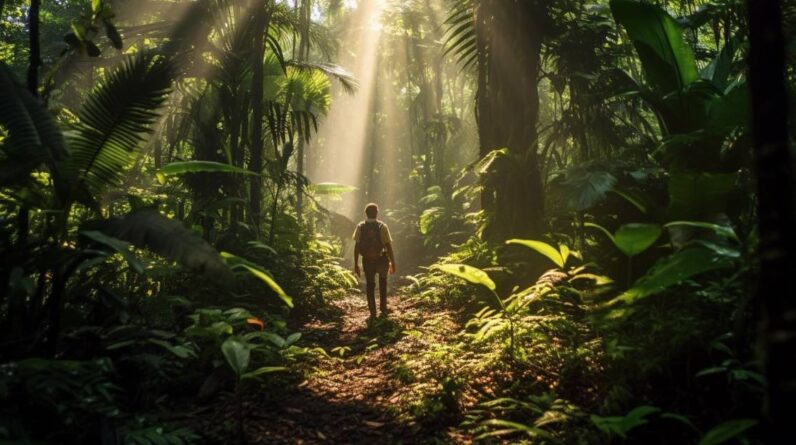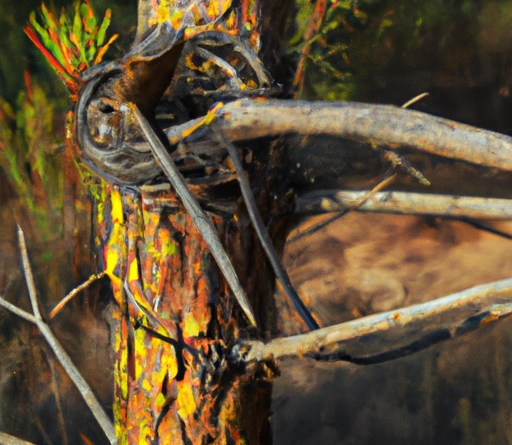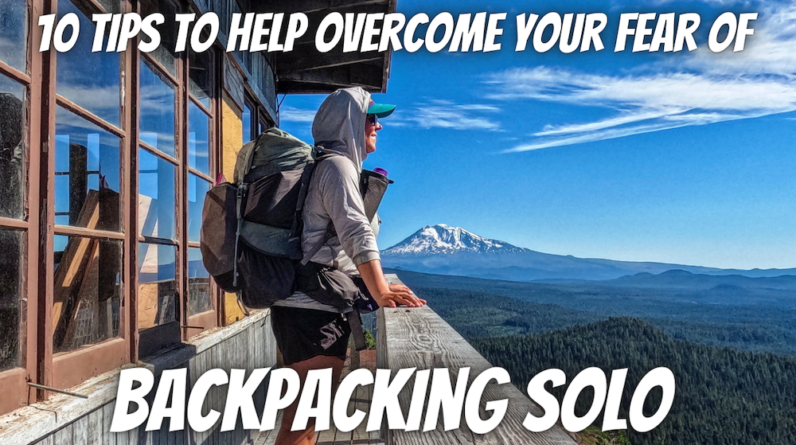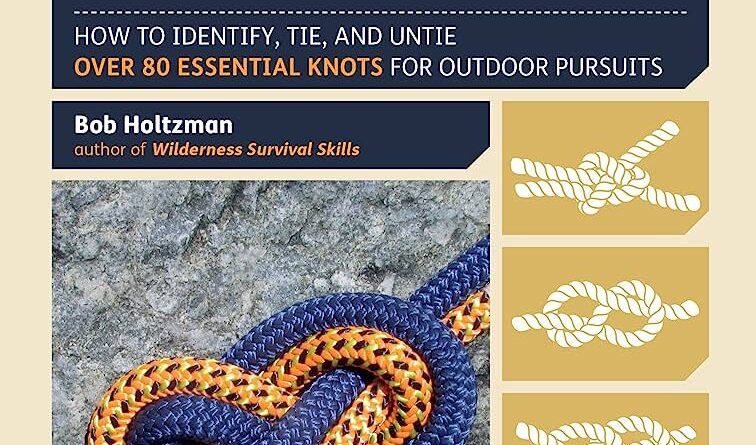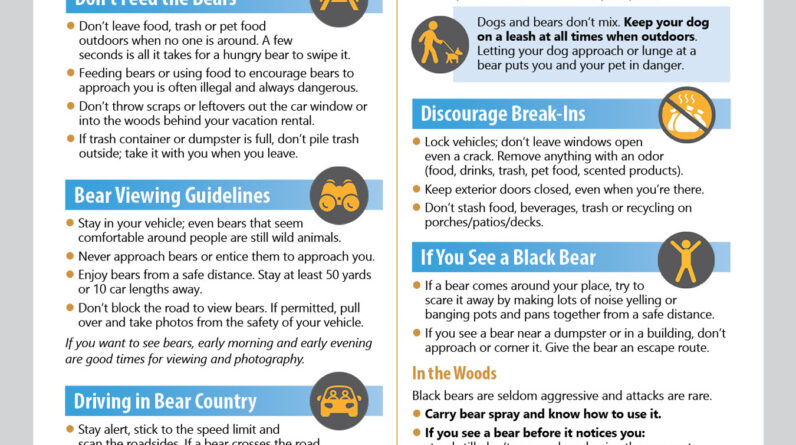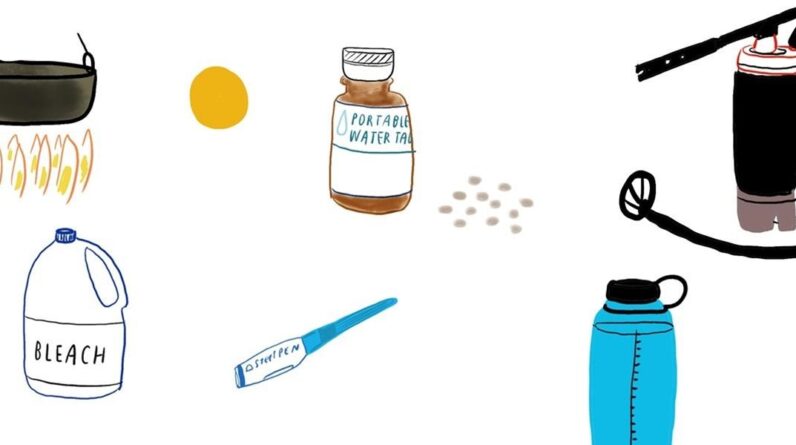
Introduction
When you find yourself in the wilderness, having access to clean and safe drinking water is essential for your survival. However, the water you encounter in these treacherous environments may be contaminated with harmful bacteria and parasites. That’s why knowing how to purify water in the wilderness is a crucial skill to acquire.
Boiling Water
The easiest and most effective way to purify water in the wilderness is by boiling it. By bringing the water to a rolling boil for at least one minute (or three minutes at elevations above 6,562 feet), you can kill off most harmful organisms. Remember to let the water cool down before drinking!
Using Water Filters
Water filters are also a reliable option for purifying water in the wilderness. These portable devices remove bacteria, protozoa, and even some viruses, making the water safe to drink. It’s important to choose a filter that meets your specific needs and meets the required industry standards.
Chemical Water Treatment
Chemical water treatment products, such as chlorine tablets or iodine drops, offer an effective way to purify water in the wilderness. These chemicals kill off harmful bacteria and viruses but can take longer to work compared to boiling or using a filter. Follow the instructions carefully to ensure proper dosage and wait times.

Understanding the Importance of Purifying Water
When you find yourself in the enchanting wilderness, it’s easy to get caught up in the beauty and serenity of nature. However, it’s crucial not to overlook the potential risks that may lurk within the water sources you encounter. Understanding the importance of purifying water is paramount to your health and safety in the great outdoors.
Risk of Contaminated Water
In the wilderness, natural water sources can be contaminated with various microorganisms, including bacteria, viruses, and parasites. These contaminants can cause severe illnesses such as diarrhea, vomiting, and even life-threatening conditions. To avoid falling victim to these dangers, it’s imperative to purify any water you consume.
Waterborne Diseases in the Wilderness
Leptospirosis, Giardiasis, and Cryptosporidiosis are just a few examples of waterborne diseases that can be contracted in the wilderness. These illnesses can have debilitating effects on your body, leaving you weak and unable to enjoy your adventure. By purifying your water before drinking, you significantly reduce the risk of falling victim to these diseases and ensure a safer journey.
Purifying water in the wilderness is an essential skill every explorer must possess. By taking the time to understand the importance of water purification and the risks associated with consuming contaminated water, you are equipping yourself with the knowledge and tools necessary to stay healthy and enjoy your wilderness experience to the fullest. So, remember, don’t take any chances – purify your water and drink with confidence!
Types of Water Sources in the Wilderness
When you find yourself in the wilderness, one of the most important skills to have is the ability to purify water. Without access to clean and safe drinking water, your chances of survival decrease significantly. In this article, we will explore the various types of water sources you may encounter in the wilderness and provide essential tips for purifying them.
Natural Springs
Natural springs are a reliable and common water source in the wilderness. These are underground water sources that bubble up to the surface, often indicating purity. However, it is still crucial to purify this water before consuming it. Use a water filter to remove any debris or contaminants, and then boil the water for at least five minutes to kill any remaining pathogens.
Rivers and Streams
Rivers and streams are another common water source in the wilderness, but they can be more challenging to purify. Contaminants such as bacteria and parasites are more prevalent in these water bodies. Your best bet is to use a water filter to remove larger particles, followed by boiling the water to ensure it is safe for drinking.
Lakes and Ponds
Lakes and ponds are often stagnant water sources, making them more susceptible to contamination. However, with the right purification methods, you can still make these water sources safe to drink. Begin by using a cloth or coffee filter to remove any visible particles. Then, apply a water treatment method such as boiling or using a water purification tablet to eliminate harmful pathogens.
Remember, water purification is an essential skill, and knowing the different types of water sources you may encounter in the wilderness will help you make informed decisions on how to purify them effectively. Stay safe and hydrated!

Methods of Water Purification
Boiling
Boiling water is one of the most effective and reliable methods for purifying water in the wilderness. All you need is a heat source, such as a campfire or stove, and a container to hold the water. Simply bring the water to a rolling boil for at least one minute (or three minutes at higher altitudes) to kill any harmful bacteria, viruses, and parasites that may be present. Boiling is particularly useful when you don’t have access to other purification methods.
Chemical Treatment
Chemical treatment is another popular method for purifying water in the wilderness. You can use iodine tablets or chlorine dioxide drops, which are compact and lightweight. Follow the instructions provided with the chemical treatment product to ensure proper usage. Typically, you’ll need to add a specific number of drops or tablets to a certain volume of water and let it sit for a specific amount of time before it is safe to drink. This method effectively kills most microorganisms, but it may not remove certain chemicals or heavy metals.
Filtration
Filtration is ideal for removing particles and sediments from water sources. Portable water filters are designed to effectively remove bacteria, protozoa, and sometimes viruses from water. Look for filters with a pore size of less than 0.2 microns for optimal purification. Most filters are easy to use and require no additional chemicals or equipment. However, they may not remove certain chemicals or viruses, so it’s important to check the specifications of your filter before relying solely on this method.
when it comes to purifying water in the wilderness, boiling, chemical treatment, and filtration are three effective methods you can use to ensure the water you find is safe to drink. Each method has its advantages and limitations, so consider carrying a combination of purification methods to adapt to different situations. Remember, clean, safe water is essential for your health and well-being in the wilderness.

Choosing the Right Purification Method
When you’re out in the wilderness, one of the most crucial aspects of your survival is having access to clean and safe drinking water. But how do you ensure that the water you find in the wild is free from harmful bacteria and contaminants? Here are some essential tips for purifying water in the wilderness.
Considering the Water Source
Before choosing a purification method, it’s essential to evaluate the water source. Is it a fast-flowing river, a stagnant pond, or a mountain stream? Each source may require a different approach. Fast-flowing water might be relatively safer than stagnant water, but it can still contain harmful microorganisms. On the other hand, stagnant water is a breeding ground for bacteria and parasites. Understanding the nature of your water source will help you determine the best purification method.
Convenience and Portability
When you’re in the wilderness, carrying heavy purification equipment is not practical. Look for purification methods that are lightweight and portable. There are various options available, such as water purification tablets, filtration systems, and UV pens. Consider the ease of use and how well the purification method fits into your backpack.
Effectiveness of the Method
No matter how convenient a purification method may seem, it’s essential to consider its effectiveness. Water purification tablets are generally easy to use and lightweight, but they may not completely eliminate certain bacteria and viruses. Filtration systems, on the other hand, can remove larger particles but may not be effective against viruses. UV pens are highly effective but require batteries. Choose a method that suits your needs and provides the necessary level of purification for the specific contaminants present in your water source.
Remember, choosing the right purification method is crucial for your safety and well-being in the wilderness. By considering the water source, convenience, portability, and effectiveness, you can ensure that the water you drink on your outdoor adventures is safe and clean.
Proper Techniques for Boiling Water
When you find yourself in the wilderness, one of the most crucial survival skills you can possess is the ability to purify water. Without access to clean water sources, you put yourself at risk of dehydration and waterborne illnesses. Boiling water is one of the simplest and most effective methods to ensure your water is safe to drink. Let’s dive into the proper techniques for boiling water.
Importance of Bringing the Water to a Rolling Boil
Bringing water to a rolling boil is essential for eliminating harmful bacteria, viruses, and parasites that may be present. As the water reaches its boiling point of 212 degrees Fahrenheit (100 degrees Celsius), the high temperature kills off these microorganisms, making the water safe for consumption. Remember to watch for the formation of bubbles and the vigorous movement of the water.
Duration of Boiling
To make sure all the potentially harmful microorganisms are destroyed, maintain a rolling boil for at least one minute. If you are at a higher altitude, where water boils at a lower temperature, it’s recommended to boil it for three minutes instead. This longer duration compensates for the lower temperature, ensuring thorough purification.
Cooling and Storing Boiled Water
After boiling your water, allow it to cool naturally without adding any ice or cold water. Then, transfer it to clean, airtight containers for storage. This prevents recontamination and keeps the water safe to drink. Remember that even boiled water should be consumed within a reasonable timeframe, as it can still be subject to bacterial growth over time.
By following these proper boiling techniques, you can confidently purify water in the wilderness and protect yourself from water-related health risks. Stay hydrated and stay safe!

Using Chemical Treatments Effectively
When it comes to purifying water in the wilderness, chemical treatments are a highly effective method. They are lightweight, easy to use, and readily available. However, it’s important to know how to use these chemicals properly to ensure the water is safe for consumption.
Common Chemicals for Water Purification
There are several common chemicals that you can use to purify water in the wilderness. One popular option is iodine tablets, which effectively kill bacteria, viruses, and protozoa. Chlorine dioxide tablets are another great choice, as they not only kill microorganisms but also eliminate unpleasant tastes and odors. Additionally, you can use granular calcium hypochlorite, commonly known as pool shock, by dissolving it in water to create a chlorine solution.
Measuring and Adding Chemicals
To effectively use chemical treatments, it’s essential to measure and add the right amount of chemicals to your water. Follow the instructions provided with the specific treatment you choose. Generally, one tablet or a specific volume of chemical solution is added per liter of water. You can use a measuring cup or a dropper to ensure accuracy.
Waiting Time for Chemical Treatment
After adding the chemicals to your water, you must wait for a specific period before drinking it. This waiting time allows the chemicals to work effectively in killing any harmful microorganisms. The recommended waiting time can vary depending on the chemical treatment used and the water temperature. It is typically around 30 minutes to two hours.
By following these tips and using chemical treatments effectively, you can ensure that the water you drink in the wilderness is safe and free from harmful contaminants. Stay hydrated and stay healthy on your outdoor adventures!
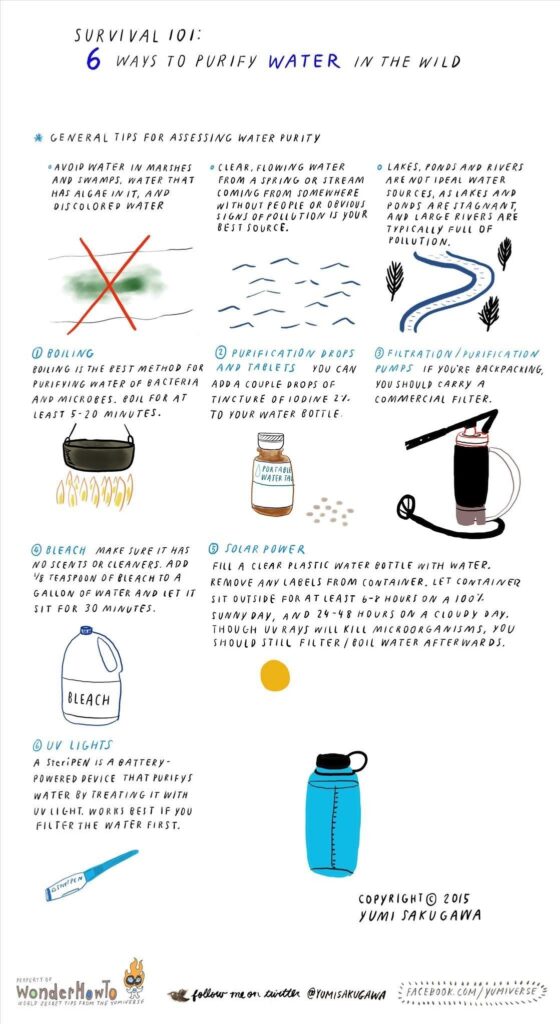
Conclusion
In conclusion, ensuring that you have access to clean and safe water is crucial when venturing into the wilderness. The risks of consuming contaminated water can be severe, leading to illnesses like diarrhea or even more serious conditions. Therefore, it is essential to follow the proper steps for purifying water in the wild.
Boiling water is one of the most effective methods to kill bacteria, viruses, and parasites. Remember to bring your water to a rolling boil for at least one minute. This simple technique can greatly reduce the risk of waterborne illnesses.
Water filters are a convenient and efficient way to remove harmful contaminants from water sources. Make sure to choose a filter that can effectively remove bacteria, protozoa, and other pathogens. Additionally, consider the size and weight of the filter, as this can greatly impact your backpack load.
Chemical treatments like iodine tablets or chlorine dioxide drops are lightweight and easy to carry. They can effectively kill many waterborne pathogens. However, make sure to carefully follow the instructions provided by the manufacturer to achieve optimal results.
Remember, when in doubt, it is always better to err on the side of caution and properly purify your water before consuming it. By following these essential tips, you can ensure a safe and enjoyable wilderness experience. Stay hydrated and stay safe!



